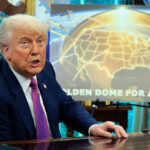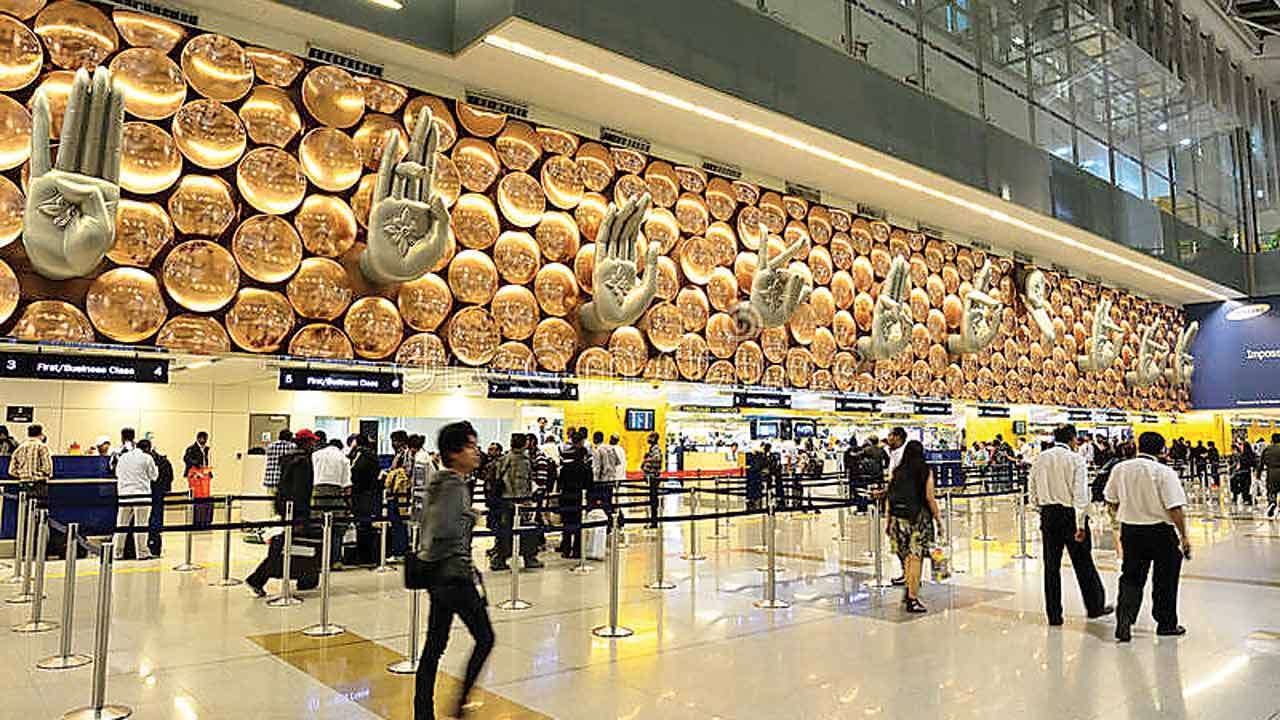In one of his most striking television appearances in recent memory, former U.S. President Donald Trump gave a candid, wide-ranging interview on CBS’s 60 Minutes. The conversation, which covered everything from America’s nuclear capability and global arms races to immigration, the economy, and partisan gridlock, quickly became one of the most discussed political moments of the year.
Trump’s blunt assertion that the United States possesses “enough nuclear weapons to blow up the world 150 times” — coupled with his defense of potential nuclear testing and claims about Russia and China secretly conducting tests — sparked intense reactions across the political and scientific spectrum. The interview also touched on his self-proclaimed success in preventing a nuclear conflict between India and Pakistan, his stance on Iran, and his unrelenting criticism of Democrats for the ongoing government shutdown.
1. The Big Statements: What Trump Actually Said
During the interview, Trump made several headline-grabbing claims. Among them:
- “We’ve enough nuclear munitions to blow up the world 150 times.”
- “Russia and China are secretly testing nuclear weapons. We need to make sure ours are the best, the strongest, and the most reliable.”
- “I averted a nuclear conflict between India and Pakistan — nothing gives me credit for that.”
- “Democrats are responsible for this government shutdown. They care more about illegal immigrants than about American workers.”
- “Iran is playing games again, but they know we won’t be fooled.”
Each of these statements is provocative in its own way, but it’s the nuclear talk that has drawn the most scrutiny. To understand why, we need to unpack both the factual and symbolic layers of Trump’s rhetoric.
2. “Enough to Blow Up the World 150 Times”: What That Actually Means
Trump’s claim about America’s nuclear capacity is not a scientific statement — it’s a rhetorical one. The United States currently possesses thousands of nuclear warheads, both deployed and stored, with an overall explosive yield that could indeed destroy human civilization many times over.
However, “blowing up the world 150 times” isn’t a measurable standard; it’s a hyperbolic way to convey overwhelming power. In practical terms, even a fraction of the existing U.S. arsenal would cause irreversible global catastrophe if ever used in war.
The number of nuclear weapons globally has decreased since the Cold War peak, but the destructive potential remains astronomical. The U.S. and Russia together still hold more than 90% of the world’s nuclear weapons. Trump’s exaggeration reflects a longstanding political trope: using massive overstatement to emphasize deterrence strength.
3. The Context: U.S., Russia, and China in a Renewed Nuclear Competitio
Trump’s nuclear remarks fit into a larger narrative of renewed great-power competition. In recent years, tensions between Washington, Moscow, and Beijing have intensified over military modernization, missile defense systems, and the future of arms-control treaties.
Trump claimed that Russia and China are conducting “secret” nuclear tests. While the veracity of that statement is disputed, it underscores his belief that the U.S. must remain dominant. His message was clear: if America’s rivals are modernizing, the U.S. should too — even if that means resuming nuclear testing.
The irony, however, is that the United States has not conducted an explosive nuclear test since 1992. Instead, it relies on sophisticated computer simulations and subcritical experiments to ensure the reliability of its arsenal. These non-explosive methods have been endorsed by successive administrations, both Republican and Democrat, as effective and compliant with the international test-ban norm.
4. Nuclear Testing: The Legal and Diplomatic Tightrope
Trump’s suggestion that the U.S. might need to resume nuclear testing immediately set off alarm bells among scientists and diplomats. The Comprehensive Nuclear-Test-Ban Treaty (CTBT), though not ratified by the U.S. Senate, has established a powerful global norm against full-yield tests. Only a handful of nations have conducted such tests in the 21st century.
Resuming U.S. nuclear tests would shatter that decades-long taboo. It would likely prompt Russia, China, and possibly others to follow suit, igniting a new round of global testing and undermining the credibility of American leadership in nonproliferation efforts.
Arms-control experts warn that the U.S. has no technical need to conduct full-yield nuclear tests. Its existing arsenal is already secure and reliable thanks to the “Stockpile Stewardship Program,” which uses supercomputing and advanced diagnostics. A resumption of testing, they argue, would be political rather than scientific — a move designed to project toughness rather than achieve technical necessity.
5. Technical Realities: Why Testing Is Considered Unnecessary
Modern nuclear weapons are not like the crude designs of the 1940s and 1950s. The United States maintains an arsenal built from tested and proven warhead designs, updated with cutting-edge monitoring and simulation technology.
Subcritical experiments — those that do not produce a self-sustaining chain reaction — provide the necessary data to ensure that warheads remain safe and reliable without violating the test ban. Advanced computer models, drawing on decades of data, can predict performance with extraordinary precision.
In short, from a purely scientific standpoint, there is no need to detonate nuclear weapons again. The U.S. can maintain its deterrent credibility without triggering global backlash or environmental harm.
6. The Environmental and Human Cost of Testing
Trump’s remarks also revived memories of the human toll of past nuclear testing. Between 1945 and 1992, the U.S. conducted over a thousand nuclear tests, many of them in Nevada and the Pacific. Communities downwind of test sites suffered radiation exposure that led to cancers, birth defects, and long-term ecological damage.
Environmental groups warn that resuming testing would not only undermine global norms but could also expose future generations to the same risks. Even underground tests can release radioactive materials into the air and groundwater. The moral and health consequences would be immense — and public opposition, fierce.
7. “I Prevented a Nuclear War Between India and Pakistan”
Another claim from Trump’s 60 Minutes interview that raised eyebrows was his statement that he had “prevented a nuclear conflict between India and Pakistan.” He appeared to refer to the 2019 Pulwama–Balakot crisis, when tensions between the two nuclear-armed neighbors soared after a terrorist attack on Indian security forces.
While Trump and U.S. officials did play a role in urging restraint at that time, his claim to have single-handedly prevented war is, at best, a self-congratulatory stretch. Diplomats from multiple countries, including the United Arab Emirates and China, were also involved in de-escalation efforts.
Nonetheless, the statement underscores Trump’s continuing fascination with projecting himself as a peacemaker in some of the world’s most volatile regions — even as he touts overwhelming U.S. military power elsewhere.
8. Immigration, Shutdowns, and the Domestic Angle
Beyond nuclear matters, Trump’s interview also veered into familiar domestic territory: immigration, the economy, and partisan gridlock. He blamed Democrats for the ongoing government shutdown, accusing them of prioritizing “illegal immigrants over American workers.” He defended the construction of additional border barriers and hinted that deportation raids under his administration “didn’t go far enough.”
This is the language that fuels his base: voters who see tough immigration enforcement as a sacred promise and a government shutdown as a display of courage, not chaos. It’s a perfect snapshot of his political playbook—a style that guarantees fervent loyalty from his supporters and ensures perpetual conflict with everyone else.
9. The Mamdani Reference: A Curious Name-Dro
Amid the gravelly debate over atomic arsenals, a single name landed like an unexpected guest: Mamdani. In a speech orbiting the heavens of high-statecraft, this was a sudden, terrestrial jab. The reference, a stark silhouette against the broader canvas of national security, was pure Trump—a political artist who never met a philosophy he wouldn’t pin to a person.
The policy itself wasn’t the point; it was the portrait he was painting. That lone name, Zohran Mamdani, became less an individual and more an emblem, a hastily sketched effigy of a whole worldview. For those watching, it was never about the man, but the mirror Trump was holding up, using one face to reflect an entire ideological opposition he wanted to define.
10. The Legal Backdrop: Trump’s Return to 60 Minutes
The 60 Minutes interview was also symbolically charged because it marked Trump’s first appearance on the program after a long and public legal battle with CBS. Earlier in the year, Trump had sued the network, claiming misrepresentation in a previous interview segment. The lawsuit ended in a settlement, paving the way for his return.
This background gave the exchange a confrontational undertone. Both Trump and interviewer Norah O’Donnell appeared prepared for verbal sparring. The conversation’s tense energy was palpable — part political theatre, part policy discussion.
11. Global Reactions: Allies Concerned, Adversaries Alert
Within hours of the interview airing, governments and analysts around the world began parsing Trump’s words.
U.S. allies expressed concern that any hint of resuming nuclear testing could destabilize international arms control architecture. European officials quietly urged Washington to clarify that no new tests were planned. In Asia, countries under the U.S. nuclear umbrella — Japan and South Korea — sought reassurance that American policy would remain steady.
Adversaries, meanwhile, seized on the remarks for their own narratives. Russian state media portrayed Trump’s words as proof of U.S. hypocrisy, while Chinese outlets framed them as justification for Beijing’s ongoing military modernization.
Even without a concrete policy shift, the perception of possible U.S. testing can have real-world effects. It could spur other powers to accelerate their own programs — or use the rhetoric as a bargaining chip in future arms control negotiations.
12. Could the President Actually Order a Nuclear Test?
While the legal path for a president to order a nuclear test exists on paper, the actual machinery of making it happen is a labyrinth. The decision would instantly ripple through a hidden ecosystem of government agencies, primarily activating the National Nuclear Security Administration. Their complex facilities in the Nevada desert are not on a hair-trigger; they exist in a state of deep hibernation. Waking them would be a monumental undertaking, a slow and meticulous dance of engineering and safety protocols stretching over many months.
Issuing such an order would be less like flipping a switch and more like throwing a stone into a still pond—the initial splash is just the beginning. The ensuing ripples would be immediate and turbulent: a firestorm of congressional investigations, global condemnation that would reshape diplomatic alliances, and a profound public reckoning. The technical gears can still turn, but the political and global tremor would be seismic, a price extracted not in dollars, but in trust and stability.
13. Strategic Rationale vs. Strategic Risk
Supporters of Trump’s hawkish stance might argue that demonstrating nuclear readiness deters adversaries and reassures allies. In theory, a test could signal credibility — proof that America’s arsenal isn’t just large but fully functional.
However, critics counter that such a move would backfire spectacularly. It could launch a new global arms race, erode the moral authority of the United States, and make the world far more dangerous. Once one major power resumes testing, others will feel compelled to do the same, breaking down decades of restraint.
Strategic stability depends as much on predictability as on power. Trump’s off-the-cuff suggestion, if turned into policy, could upend that balance.
14. The Communication Strategy: Power Through Provocation
Trump’s communication style has always relied on shock value. Whether discussing domestic policy or foreign affairs, he uses hyperbole to dominate headlines. Saying America can “blow up the world 150 times” accomplishes exactly that — it grabs attention, sets the news agenda, and reestablishes him as a commanding, larger-than-life figure.
To his supporters, this bluntness is a sign of authenticity — a willingness to say what others won’t. To his critics, it’s reckless and dangerous, especially when dealing with matters as grave as nuclear weapons. Either way, the tactic works: the entire conversation shifts to his framing.
15. Expert Reactions: Alarm Bells Ring Across the Spectrum
A dissonant chorus of strategic sentinels and planetary guardians swiftly countered the former president’s assertions. Their collective critique hinged on a foundational principle: true atomic assurance is not a product of apocalyptic theater, but of a calculated, unflinching equilibrium. They posited that mere whispers of resumed detonations could fracture the fragile edifice of international arms diplomacy, poisoning future parlays with global nuclear actors.
Simultaneously, a lament arose from ecological custodians, who framed the proposition as a toxic anachronism. They warned of resurrecting specters from a sepia-toned age of mutual assured destruction, threatening to irradiate pristine biomes and inflict generational poison upon the very fabric of life.
16. Historical Parallels: Lessons from the Past
Trump’s nuclear rhetoric recalls earlier periods of nuclear tension — from the Cuban Missile Crisis of 1962 to the arms-race escalation of the 1980s. During those times, both the U.S. and the Soviet Union learned, often painfully, that excessive posturing could bring the world to the brink of annihilation.
In contrast, the post–Cold War era built its security architecture on restraint. Treaties like START, New START, and the CTBT sought to limit not just the number of weapons but the habits of testing and deployment that fed the arms race.
Undoing that architecture could unravel decades of painstaking diplomacy. It would also send a dangerous signal to emerging nuclear states that the old powers no longer honor their commitments.
17. The Human Element: Why Rhetoric Matters
Words alone may not start wars — but they shape the environment in which wars become possible. When a former or current U.S. president speaks casually about nuclear testing or global annihilation, the psychological effect ripples across capitals and markets.
Diplomats interpret such language as intent. Military planners adjust assumptions. Adversaries recalibrate their strategies. Even if Trump’s statements were primarily rhetorical, they introduce uncertainty — and uncertainty, in the nuclear domain, is itself a source of danger.
18. The Domestic Political Implications
Trump’s 60 Minutes appearance also carries domestic political weight. It reinforces his image among supporters as a strong, unapologetic leader who prioritizes national security above political correctness. For opponents, it reaffirms fears that he could make impulsive decisions with global consequences.
The interview’s timing, amid a prolonged government shutdown and renewed debates over border security, allows Trump to reclaim the national spotlight and control the narrative. In an election season defined by polarization, every word he utters becomes ammunition — for both sides.
19. What Happens Next
Following such an explosive interview, several key developments are likely:
- Official Clarifications: The White House or campaign may issue statements softening or contextualizing Trump’s remarks, insisting that no actual test is planned.
- Congressional Oversight: Lawmakers may demand briefings on the status of U.S. nuclear readiness and any discussions about testing.
- International Diplomacy: Allies will quietly seek assurances that U.S. policy remains steady.
- Public Debate: Advocacy groups, think tanks, and the media will continue dissecting the implications, ensuring the issue remains in the headlines.
Ultimately, whether Trump’s words translate into policy will depend on who surrounds him — the advisers, scientists, and generals tasked with balancing rhetoric and reality.
20. Final Analysis: Rhetoric, Power, and Responsibility
Donald Trump’s 60 Minutes interview was more than just another media appearance; it was a reminder of how profoundly a few sentences from a political leader can influence global perception. His statements about nuclear weapons — their number, their use, and their testing — blend bravado with a deep-seated belief in strength through dominance.
Yet nuclear power is not just a symbol of strength; it’s a burden of responsibility. Every generation of leaders since Hiroshima has wrestled with that paradox. To speak casually about “blowing up the world 150 times” risks trivializing the immense moral and existential stakes involved.
Whether one views Trump’s words as strategic signaling, political theatre, or genuine conviction, they force the world to confront uncomfortable questions about deterrence, diplomacy, and the thin line between security and catastrophe.










